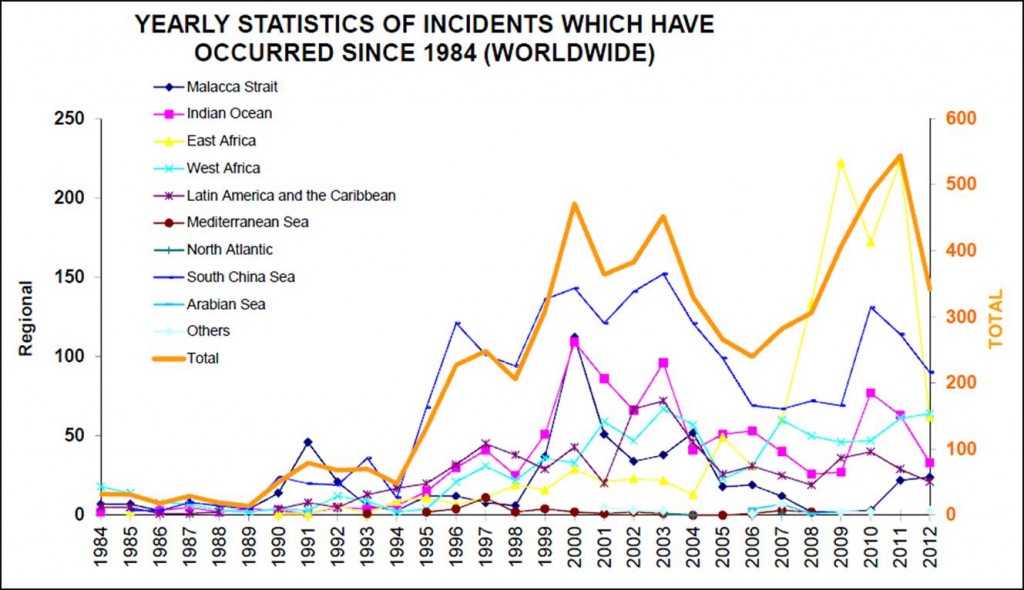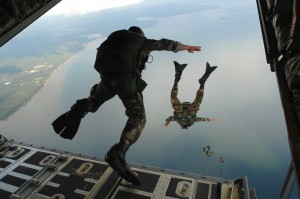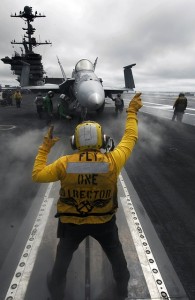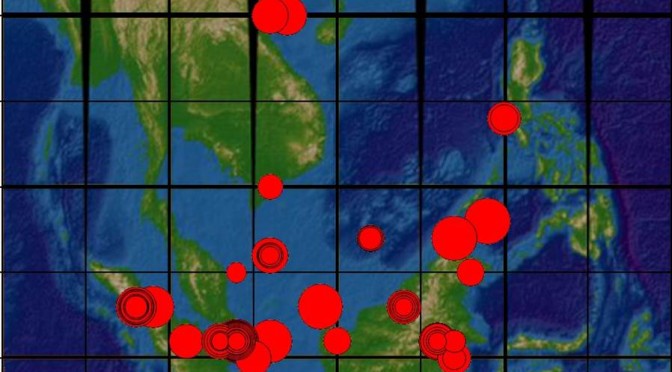 Alex Clarke interviews Ian Gardiner about the Falklands War and 45 Commando Royal Marines. This is part of the ongoing Sea Control East-Atlantic series on the Falklands War.
Alex Clarke interviews Ian Gardiner about the Falklands War and 45 Commando Royal Marines. This is part of the ongoing Sea Control East-Atlantic series on the Falklands War.
Piracy in the South China Sea: Petty Theft in Indonesia, Kidnapped Ships in Malaysia
By Sarah Schoenberger
Armed with AK47s and equipped with GPS devices, modern pirates pose a serious non-traditional security threat to all seafaring nations, their people, and economies. In 2012, five crew members were killed in pirate attacks, 14 wounded, and 313 kidnapped; and the world economy lost about US$6 billion through disrupted maritime logistic chains, higher insurance premiums, and longer shipping times. While most associate piracy with hijacked ships and abandoned crews around Somalia, the area with the most pirate attacks in recent years has been the South China Sea. While the most severe attacks here occur primarily in Malaysia, 78 percent of the incidents in 2012 took place at Indonesian ports and concerned small cases of petty theft.
This analysis is based on data by the International Maritime Organization (IMO), a UN specialized agency for maritime security. The UN Convention on the Law of the Sea (UNCLOS) defines piracy as an illegal act of violence committed for private ends by the crew or passengers of a ship or aircraft against another ship or aircraft on the high seas; the IMO extends this definition to include “armed robbery against ships”—pirate attacks within a state’s territorial sea.
According to the IMO, piracy worldwide has risen substantially since 1994 with incident peaks of about 470 and 550 in 2000 and 2011, respectively (see Figure 1). This is primarily due to the exponential increase of global shipping in the course of globalization—leading to 80 percent of world trade being shipped across oceans today—with which opportunities for piracy increased likewise. The real number of pirate attacks are thereby even higher: An estimated two-thirds of all pirate attacks remain unreported, as shipping companies skirt the bad publicity, higher insurance premiums, and investigation delays that come with reporting incidents.
With the exception of 2007 to 2012, when piracy in East Africa experienced a sharp increase, the South China Sea has been the most piracy-prone region in the world, with up to 150 attacks per year. Why? First, about 30 percent of global maritime trade passes through the region, so opportunities for attacks are plenty. Second, the area’s geographical features foster piracy, as the island chains and small rocks constitute ideal hiding places, while the narrow passages facilitate attacks. Third, unresolved territorial issues and lack of agreed jurisdiction, particularly around the Spratley and Paracel Islands, complicate maritime enforcement and patrols and thus facilitate illegal activities at sea.
While pirate attacks in the South China Sea are spread across the entire area, the majority happen around Indonesia: Of 85 incidents with a known location in 2012, 66 occurred in Indonesia, 10 in Malaysia, 3 in the Philippines, 2 in Singapore and 4 in Vietnam. Indonesia’s geographical features and the increased efforts of Malaysia and Singapore to combat piracy in the Strait of Malacca explain the predominance in Indonesia. Here, efforts to fight piracy are weak, cooperation of corrupt port officials is high, and punishment for piracy rather light.
In Indonesia, Vietnam, and the Philippines, most attacks occur at ports, whereas none happened in the Singaporean port. In Malaysia, the majority of incidents occurred on the high seas (see Figure 2). Taken together, this leads to a regional average of 67 percent ‘port-attacks’ in 2012, while only 13 percent happened on the high seas. In this regard, the South China Sea is distinct compared to the rest of the world, where more than a third of all pirate attacks are committed on the high seas.
To know more about the nature of the incidents in the different countries, the severity of the attacks can be calculated. Taking the four variables, (A) number of pirates taking part in an attack, (B) weapons used, (C) content stolen, and (D) amount of violence employed, the grade of severity is established by scaling the four variables appropriately (0.5A-2B-2C-3D), using them as axes in a four-dimensional coordinate plane and employing a point-distance formula of the point A/B/C/D to the origin.

Linking the severity with the location of attacks yields the map in Figure 3 (the larger the bubble, the more severe the attack; when several attacks of different severity took place in the same location, they are marked by black lines). While no hot spot is obvious, it is apparent that attacks in vicinity of Malaysia and Singapore were more severe (at an average severity of 37.5 and 34, respectively, on a scale from 8.5 to 59.5), while the mildest ones occurred in Indonesia at 24. The Philippines and Vietnam range in the middle at 29.5 and 26.7.
Comparing the severity with the area of attack in the different countries, two types of piracy become apparent. The first one is exemplified by attacks in Indonesia, which occur at ports and are not that severe. These are usually carried out by four pirates armed with knives, guns, or machetes; they target the crew’s personal belongings and the ship’s stores without employing much violence. These attacks can be characterized as low-profile piracy, which is generally conducted by un(der)employed fishermen or idle dock workers. As they lack resources, the attacks are ill-organized and opportunistic and exercised where security measures are low, law enforcement weak, and the concentration of shipping high.

In contrast, severe high-profile piracy occurs primarily on the high seas. It is carried out by well-organized international piracy syndicates, which have substantial means at their disposal and use modern techniques and equipment. In the South China Sea, this type of high-profile piracy is most evident in Malaysia. On average, these are carried out by 11 pirates armed with knives and guns; they hijack the ship and take the crew hostage or abandon it in life rafts.
The most self-evident explanation for the difference of low- and high-profile piracy in Indonesia and Malaysia is the disparity in living standards and wealth. In Indonesia, where the GDP per capita was US$5,100 in 2012, piracy attacks are much more likely to be motivated by poverty. Local fishermen do not have the means, or the motivation, to conduct high-profile attacks, but simply seek money and food—making Indonesian piracy less severe. In Malaysia, with a GDP per capita of US$17,200 in 2012, poverty is not as high and there is less necessity for fishers to conduct low-scale piracy attacks in order to survive. Instead, piracy attacks here are conducted by organized crime syndicates, entail much more criminal energy, and are more severe. Other factors that have an impact on the prevalent type of piracy include the amount of port security measures, the degree of law enforcement, and the strength of penalties.

Understanding the nature of piracy in the South China Sea leads to several implications for its combat. As most attacks happen in harbors, increased port and ship security measures would be highly effective in reducing the number of these incidents. In addition, stricter law regulation and enforcement mechanisms, as well as training for local port officials would be useful. Both these measures should be conducted in multilateral settings, like regional Piracy Law Dialogues or Conferences. They should include regional government officials, legal experts, representatives from the IMO and IMB, the shipping community, and other non-regional states with an interest in combating piracy in the South China Sea.
To address the cases on the high seas, any military mission patrolling the waters and accompanying ships (such as the successful NATO Operation Ocean Shield in the Gulf of Aden) would be highly controversial and inadvisable due to the possible escalation of territorial tensions. Instead, a joint coast guard system with common patrols could be much more effective.
For a country-specific course of action, the incidents in the respective country should be analyzed more closely, looking inter alia at the specific locations of the attacks with their surrounding circumstances and the general structure of criminality in the country. Nevertheless, based on the results of this analysis, piracy in the South China Sea in general can be much reduced if the root causes of unemployment and poverty in Indonesia are addressed. Through the depletion of resources, limitation of fishing grounds due to territorial tensions, and competition from large international fisheries that outclass them in the open sea, local fishermen can no longer sustain themselves by their livelihood. Facing a dearth of other employment opportunities, there is often little choice but to commit low-scale opportunistic crimes around harbors—and thereby become pirates.
Sarah Schoenberger is a postgraduate student of International Affairs at the London School of Economics and Political Science and Peking University in Beijing. Her focus is on security studies and East Asia. This article appeared in its original form at the Indo-Pacific Review and was republished by permission.
CIMSEC DC Chapter Sept Meet-Up – Location Update
 Location Update:
Location Update:
Confirmed: Third floor, Crystal City Sport Pub
Join our DC chapter for its September meet-up with food, drinks, and conversation at Crystal City Sports Pub (location to be confirmed). At 1800 we will be joined by CIMSEC member CDR Chris Rawley, USNR, and author of Unconventional Warfare 2.0 for a brief discussion of unconventional warfare in a maritime setting followed by a Q&A. Stick around (or join us later) for our traditional informal discussions over drinks.
Time: Wednesday, 10 September 1730-2030 (Discussion with Chris Rawley will begin at 1800)
Place: Crystal City Sports Pub (Upstairs – location to be confirmed)
529 23rd St. S, Arlington VA
Crystal City metro stop (southern-most exit of the Crystal City underground)
From Chris:
Unconventional warfare (UW) is perhaps the most common form of conflict today, yet the least understood. UW operations in various forms are ongoing in Iraq, Syria, Yemen, Afghanistan, Mali, and perhaps most prominently in Ukraine. The maritime facet of UW is a relatively untapped subject and not much has been written on it. However, recent activities in the South China Sea have caused me to revisit the original Naval Unconventional Warfare article I wrote in 2007 when I suggested fishing fleets might be used as a surrogate force.
Suggested readings:
– Adam Pasick, “How China’s Enormous Fishing Fleet is Being Used as a Surrogate,” Defense One
– Alex Calvo, “Small Wars and Non-Lethal Force at Sea: Wave of the Future?” Small Wars Journal
– David A. Adams, “Repeating Three Strategic Mistakes,” Proceedings
All are welcome and we ask both presenters and questioners alike to be mindful of our diverse audience so as to avoid acronym-talk and speaking in obscure terms of reference. We reserve the right to enforce this in a comical and distracting manner. Please RSVP at director@cimsec.org.
 October Meet-up: TBD.
October Meet-up: TBD.
Please also let me know If you’re a CIMSEC member who would like to discuss a recent/on-going project or writing you’ve done at a future meet-up.
The Future of Maritime Security Studies
As part of the Fourth Global International Studies Conference held in Frankfurt (Germany) 6-9 August 2014, a series of panels was organized on Maritime Securityscapes. One of the events was a roundtable on the future of the emerging, informal subdiscipline “Maritime Security Studies”, a rapidly growing field of analysis and research. The participants were asked to provide their comments along four broad questions. The following is one participant’s input to provide food for thought and a better understanding of maritime security as an academic field of interest and study.

What are the most pressing and important questions that Maritime Security Studies (MSS) need to answer?
There are four immediate aspects to this, two of which are more inward-looking and two of which are more outward-directed. First, students of maritime security must better utilize the momentum of conditions that are in favor of the thrust of the field (e.g., the littoralization of security, the maritime [and indeed naval] dimensions of climate change, the hypothesis of the increasing utility of naval forces in future conflict scenarios, the recent publication of a cross-sectoral European Maritime Security Strategy, etc.). Second, maritime security scholars must consider, and learn to mitigate, condisations that are seemingly at odds with the thrust of the field (e.g., current land-centric conflicts, continental geopolitical and strategic thinking in policy-making circles, etc.).
Third, there must be a consistent evaluation of the contemporary relevance of maritime security, especially in light of what will come after “anti-piracy”. The naval operations off the Horn of Africa have locked the theme of security at and from the sea in the minds of many policy-makers and analysts to the degree that maritime security is often seen as exclusively about counter-piracy. Naturally, this self-imposed limitation is neither desirable nor practical. Here, it is especially the strategic-minded researchers that have an obligation to make decision-makers aware of the broad security dimensions of the maritime sphere. While they cannot prevent the career of certain terms, they should at least attempt to manage it properly. Fourth, maritime security students must consider how policy-makers can be convinced that investments in maritime security capabilities and capacities at home and aboard is beneficial. This relates to the challenge of doing critical and pragmatic studies: traditional security studies are increasingly dominated and even overpowered by constructivist approaches.

What issues should be prioritized? What are the top priorities?
As with many fields of study, the top three priorities are funding, funding, and funding. Beyond stating this obvious desire, there appears to be the need to sharpen arguments and understanding of the subject matter “Maritime Security”. For example, in Germany, “maritime security” (“maritime Sicherheit”) has become an all-encompassing term, meaing all kinds of things to all kinds of people. From a naval perspective, “maritime security” usually means just one set of missions among many others (for the U.S. Navy as laid out in the most recent U.S. Navy strategy “A Cooperative Strategy for 21st Century Seapower” from 2007; for the German Navy by default, i.e. the operational experience in counter-terrorism and anti-piracy operations since 2002/2008).
Disciples of the emerging field of study should also not forget to look at the field from a commercial and naval perspective. The defense industry, after all, is increasingly looking at littoral security and the emerging maritime safety and security missions, fishery surveillance, counter-piracy, drug interdiction, environmental protection, humanitarian aid, and SAR. Commercial shipping companies are increasingly looking at security in the littoral areas, the ports, and the choke point regions. This offers critical and pragmatic scholars an excellent starting point to link their academic work and insight with influence on actual events and developments.
Scholars should also consider to revive and revitalize the concepts of seapower/sea power in their institutional, function, and geographic dimensions (as British naval strategy dean Geoff Till reminded us once, sea power is something that certain states, or seapowers, have). In addition, it behooves to freshen up on the three uses of the sea for navies (developed by Ken Booth in 1977 and Eric Grove in 1990): diplomatic, constabulary, and military.

What are the convergences between academic and policy needs in maritime security? Are there shared gaps and how could these be addressed?
The effects of sea power and the policies that make and shape it must ultimately be felt ashore. The same goes for maritime security studies; there are inherent limits to bemoaning “sea blindness” again and again. Policy and maritime security studies both need a better understanding and appreciation of the value and virtue of naval power, and the opportunities of naval forces (presence, flexibility, versatiltiy, modularity, speed, crisis response, etc.). To that end, Maritime Security Studies disciples must learn to embrace navies (even if it means learning some dreaded military lingo and going to acronym hell and back). Navies, in turn, should learn to reach out to the academia and ask hard questions and demand sustainable answers and solutions. Whereas many navies are more about operations than about strategy, and policy-makers often confront a whole host of demands and pressures that keep them from thinking (and acting) strategically, the ultimate goal must be a closer linkage between naval officers, policy-makers, and maritime security students. Those in every field that reach out to the other two players must be identified, and the relationship could even be deepend by way of reserve duty in a navy for civilians and academic fellowships for naval officers).

How can the new maritime security studies be strengthened? What institutions will we need to undertake research collaboratively?
From a German perspective, there isn’t a single definitive center of gravity for maritime security (especially strategic) intellecutal thought, although there are a number of institutions that could collaboratively engage in maritime security studies (such as the Future Ocean cluster in Kiel, the Institute for Peace Research and Security Policy in Hamburg, and the University of the German Armed Forces). Maritime Security Studies can only be strengthened in a comprehensive manner. Geramns love the comprehensive approach but too often quickly turn a blind eye toward the indispensable military component of that approach. This requires a mapping of institutions and actors who are into the subject. The Institute for Security Policy in Kiel, with its demonstrated experience in third-party research projects and maritime security and naval strategy expertise (one PhD completed in 2009, one to be completed this year, three more due between 2015 and 2018) would be another natural player. Last, but certainly not least, the Center for International Maritime Security itself could play a role.

What are plausible next steps for Maritime Security Studies?
There should be a drive for greater institutionalization of the field through dedicated conferences, journals, university chairs, summer schools (one such event was recently organized in Greece), M.A. and PhD courses, etc. There could be a biennial maritime security studies conference – not unlike the McMullen Naval History Symposium in Annapolis, MD – that brings together experts and students from different fields (e.g., naval strategy, recent naval history, etc.). The subject at hand is interesting and exciting enough to explore more dimensions and collaboratively engage in visits on ships, war games and simulations, etc.). In the end, the goal must be to move from maritime case studies such as the dominating anti-piracy operations to the larger trends.
Sebastian Bruns is a Research Fellow at the University of Kiel’s Institute for Political Science/Institute for Security Policy. He holds an M.A. in North American Studies (U of Bonn 2007). The views he presented in Frankfurt and here are his own.





